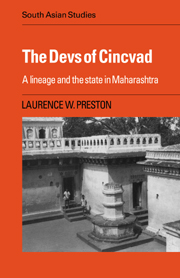Book contents
- Frontmatter
- Contents
- List of figures and tables
- Preface
- List of abbreviations and note on Indian technical usages
- Introduction: an inamdar lineage in Indian history
- PART ONE THE INAMDAR UNDER THE MARATHAS
- 1 The acquisition of inam
- 2 The preservation of inam, 1720–1818
- PART TWO THE INAMDAR UNDER THE BRITISH
- Bibliography
- Index
- CAMBRIDGE SOUTH ASIAN STUDIES
1 - The acquisition of inam
from PART ONE - THE INAMDAR UNDER THE MARATHAS
Published online by Cambridge University Press: 05 November 2011
- Frontmatter
- Contents
- List of figures and tables
- Preface
- List of abbreviations and note on Indian technical usages
- Introduction: an inamdar lineage in Indian history
- PART ONE THE INAMDAR UNDER THE MARATHAS
- 1 The acquisition of inam
- 2 The preservation of inam, 1720–1818
- PART TWO THE INAMDAR UNDER THE BRITISH
- Bibliography
- Index
- CAMBRIDGE SOUTH ASIAN STUDIES
Summary
Surveying the administration of the countryside, William H. Tone, perhaps the first European to be a serious observer of the Maratha polity, noted almost in exasperation how ‘everything respecting this extraordinary people becomes an object of curiosity’; in particular, ‘their principles of government excite our attention, as they discover a mode of thinking and acting totally different from the regular system of European policy. The very local arrangements of empire are peculiar, the territory of the different chiefs being blended and interspersed with each other.’ The Peshva and his political feudatories had detached territories all over the subcontinent. At the local level, a subdistrict or even a single village would be shared between different ‘chiefs’; even the sometime archrivals, the Nizam of Hyderabad and the Peshva, held villages in common. For ‘a disposition so chequered’ Tone could find little explanation, not even to discover whether it was ‘the effect of policy or accident.’ Although Tone confused several levels of Maratha political and economic administration, from that of imperial conquest down to very local revenue collections, his remarks strike a responsive chord in the historian attempting to understand the complexities of the Maratha government. Moreover, the situation was apparently even more chaotic than even Tone imagined. Within individual villages, for example, there existed a similar pattern of overlapping and shared control of land and revenue.
Inam was one factor creating this patchwork of revenue rights in rural Maharashtra.
- Type
- Chapter
- Information
- The Devs of CincvadA Lineage and the State in Maharashtra, pp. 23 - 45Publisher: Cambridge University PressPrint publication year: 1989



